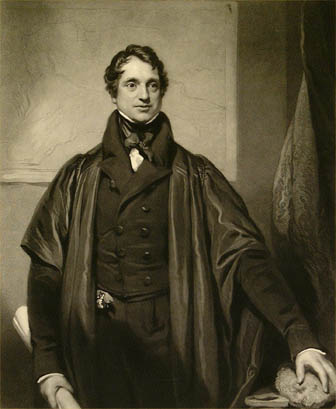Adam Sedgwick
(1785-1873)
Like every other branch of natural science founded on observation, we observe that the great mixed masses of the earth's crust are arranged in natural groups, and that the groups succeed in regular order. In describing each group, we follow the methods of natural history, whether we describe the animal species or their organic content.

ADAM SEDGWICK WAS BORN ON MARCH 22, 1785, the third of seven children of an Anglican vicar, in Dent, Yorkshire, England. His home life was happy; like so many geologists, young Adam spent time rambling through the countryside, looking at and collecting rocks and fossils. Despite his family's modest means, Sedgwick attended nearby Sedbergh School, and then entered Trinity College at Cambridge University, as a "sizar" -- a type of scholarship student. In 1810 he was made a Fellow -- a post similar in prestige, duties, and pay rate to a modern graduate student teaching assistant. As he described it in a letter, working conditions were also not unlike those faced by many a teaching assistant since:
Here I am grinding away with six pupils. Under such circumstances it is impossible to advance one step. But I am compelled by circumstances to undergo this drudgery. When I look back on what I have done since I was elected Fellow I cannot discover that I have made any proficiency whatever, or gained one new idea.
In 1817 he took holy orders, and in 1818 he became Woodwardian Professor of Geology at Cambridge, holding a chair that had been endowed ninety years before by the natural historian John Woodward. He lacked formal training in geology, but he quickly became an active researcher in geology and paleontology. During his tenure, he immensely enlarged the geological collections of Cambridge University, and carried out important field research all over Britain. Sedgwick is said to have remarked, upon being appointed Woodwardian Professor, "Hitherto I have never turned a stone; henceforth I will leave no stone unturned." In 1822 he carried out fieldwork unraveling the complex geology of the Lakes District of northern England, armed with the new discoveries and techniques of William Smith. (He met and befriended the poet William Wordsworth on this expedition, and also met the poet Robert Southey and the chemist John Dalton.) His lectures at Cambridge were immensely popular; he was a spellbinding lecturer, and -- breaking with the traditions of his time -- his lectures were open to women, whom Sedgwick thought could make great contributions to natural history. He continued to rise in his profession: in 1829 he became President of the Geological Society of London, and in 1845 a Vice-Master of Trinity College. As Vice-Master, he led campaigns to open Cambridge to non-Anglicans and to reorganize the academic programs, in the process meeting and becoming close to Queen Victoria and her consort Prince Albert. By the 1850s he was in poor health, cared for by his niece Isabella. Still, he kept giving his famous lectures until 1871.
Sedgwick was one of several great figures in what has been called the Heroic Age of geology -- the time when the great geological time periods were defined, and when much exploration and fundamental research was carried out. Sedgwick's work placed him at the epicenter of one of the most heated geological controversies of his day, stemming from his work with the gentleman geologist Roderick Impey Murchison. They explored the geology of Scotland in 1827, and in 1839 they jointly presented their researches on certain rocks in Devonshire, England, which had a distinctive fossil assemblage that led them to propose a new division of the geological time scale -- the Devonian. In the early 1830s, both men were working on the rocks of Wales, which were and are very difficult to work on due to extensive folding and faulting. However, they seemed to be older than most of the sedimentary rocks farther east. Murchison documented the presence of a distinctive set of fossils, one in which very few fish were found, but that included numerous different types of trilobites, brachiopods, and other such fossils. Murchison named the system of rocks containing such fossils the Silurian, after the Silures, a Celtic tribe living in the Welsh Borderlands at the time of the Romans. Sedgwick, who had been working in central Wales, proposed the existence of a separate system below the Silurian, which he named the Cambrian -- after Cambria, the Latin name for Wales. The two presented a joint paper in 1835, entitled "On the Silurian and Cambrian Systems, exhibiting the order in which the older sedimentary strata succeed each other in England and Wales."
"I cannot promise to teach you all geology, I can only fire your imaginations"
Sedgwick's upper "Cambrian" overlapped with the lower part of Murchison's "Silurian." Sedgwick had defined his "Cambrian" using physical characters of the rocks, which were unique to Wales, and had not relied extensively on fossils, which could be found everywhere. Murchison, who had used fossils extensively in defining the Silurian, claimed at first that the upper Cambrian, and then the entire Cambrian, were really parts of the Silurian. The resulting quarrel between the two men left them permanently estranged and took years to resolve. There was more than a simple matter of names involved. Both geologists wanted the honor of describing the rocks that recorded the beginning of life on Earth, for no fossils were known that were older than those of the Cambrian. Murchison felt that the fossils of Sedgwick's "Cambrian" were not different enough from his "Silurian" forms to merit the naming of a geologic time period, and it was some time before truly distinctive Cambrian fossils were documented. Today, following the solution worked out in 1879 by Sedgwick's colleague Charles Lapworth, geologists use both time periods, with a third one -- the Ordovician, also named for a Celtic tribe in Wales -- between the Cambrian and the Silurian, equivalent to the disputed "upper Cambrian-lower Silurian" beds. Each one of these is now known to be characterized by distinct fossil assemblages.
For one summer of his work in Wales which was to lead to this controversy, Sedgwick made a fateful choice of field assistant: a young Cambridge graduate named Charles Darwin. Darwin had passed his examinations for the Bachelor of Arts degree in January 1831, and began attending Sedgwick's geology lectures, which he found fascinating. That summer, the two men explored the rocks of north Wales; Darwin got a "crash course" in field geology from Sedgwick, an experience that would stand him in good stead over the next five years, on the round-the-world voyage of H.M.S. Beagle. During this voyage, Darwin sent rocks and fossils from South America back to Sedgwick, as well as descriptions of the geology of South America. These impressed Sedgwick, who wrote in a letter to Darwin's family:
He is doing admirably in S. America & has already sent home a Collection above all praise. -- It was the best thing in the world for him that he went out on the Voyage of Discovery...
In November 1835, before Darwin had returned to England, Sedgwick read some of Darwin's work on South American geology to the Geological Society of London. This greatly improved Darwin's reputation as a scientist; he was inducted into the Society shortly after his return. The two stayed friends until Sedgwick's death, but Sedgwick was upset and disappointed by Darwin's theory of evolution by natural selection. After reading The Origin of Species, Sedgwick candidly wrote to Darwin on November 24, 1859:
If I did not think you a good tempered & truth loving man I should not tell you that. . . I have read your book with more pain than pleasure. Parts of it I admired greatly; parts I laughed at till my sides were almost sore; other parts I read with absolute sorrow; because I think them utterly false & grievously mischievous-- You have deserted-- after a start in that tram-road of all solid physical truth-- the true method of induction. . .
Sedgwick's own geological views were generally catastrophic -- he believed that the history of the Earth had been marked by a series of cataclysmic events which had destroyed much of the Earth's life. In this belief he followed Cuvier, and he was opposed to Charles Lyell's models of slow, gradual geological change and a more or less steady-state Earth. However, Sedgwick was interested in the possibility that at least some of the "catastrophic" changes implied by the rock record might be shown to be gradual. He originally followed his collegue William Buckland in believing that the uppermost Pleistocene deposits had been laid down by the Biblical Flood, but retracted this belief after many of these deposits turned out to have been formed by glaciers, not floods. Sedgwick also did not object to evolution, or "development" as such theories were called then, in the broad sense -- to the fact that the life on Earth had changed over time. Nor was he a young-Earth creationist; he believed that the Earth must be extremely old. As Darwin wrote of Sedgwick's lectures, "What a capital hand is Sedgewick [sic] for drawing large cheques upon the Bank of Time!"
However, Sedgwick believed in the Divine creation of life over long periods of time, by "a power I cannot imitate or comprehend -- but in which I believe, by a legitimate conclusion of sound reason drawn from the laws of harmonies of nature." What Sedgwick objected to was the apparent amoral and materialist nature of Darwin's proposed mechanism, natural selection, which he thought degrading to humanity's spiritual aspirations. His letter of November 24 went on to state:
This view of nature you have stated admirably; tho' admitted by all naturalists & denied by no one of common sense. We all admit development as a fact of history; but how came it about? Here, in language, & still more in logic, we are point blank at issue-- There is a moral or metaphysical part of nature as well as a physical. A man who denies this is deep in the mire of folly. Tis the crown & glory of organic science that it does thro' final cause, link material to moral. . . You have ignored this link; &, if I do not mistake your meaning, you have done your best in one or two pregnant cases to break it. Were it possible (which thank God it is not) to break it, humanity in my mind, would suffer a damage that might brutalize it--& sink the human race into a lower grade of degradation than any into which it has fallen since its written records tell us of its history.






